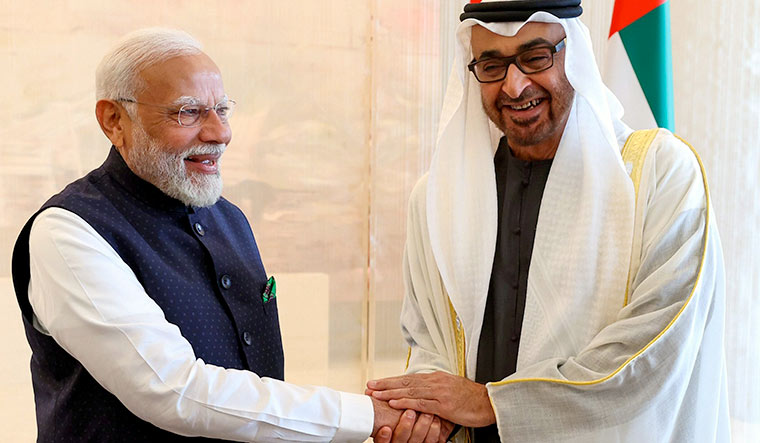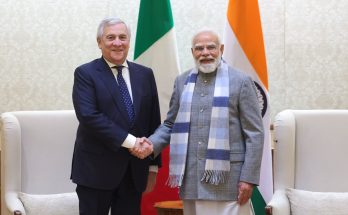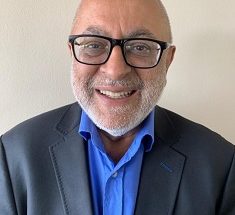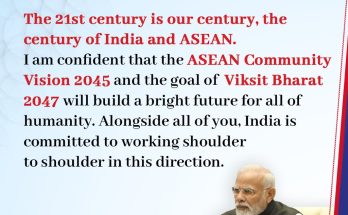The strategic partnership between India and West Asia has scaled new heights during the last decade of the Modi administration. The region will continue to figure prominently in India’s foreign and security policy matrix, says Anil Trigunayat.

A tweet from Prime Minister Narendra Modi, during his seventh visit to the UAE, says it all. The crux is that the strategic partnership has been catapulted even beyond standard strategic perspective by sheer perseverance, farsightedness and mutual trust which have exemplified mutual respect and mutual interests across the whole spectrum starting with a unique relationship at the highest level between Sheikh Mohammed bin Zayed President of the UAE and Prime Minister Narendra Modi.
भारत और UAE की दोस्ती को आज पूरी दुनिया में आपसी विश्वास और सहयोग के एक उदाहरण के रूप में देखा जाता है: PM @narendramodi
Takeaways of PM Modi’s seventh visit to the UAE
During this visit, Prime Minister Narendra Modi inaugurated the BAPS Hindu Mandir in Abu Dhabi —the first in the capital. The PM along with the Mukhya Mahant of BAPS Hindu Mandir performed all the rituals. The PM termed the Hindu Mandir in Abu Dhabi as a symbol of the shared heritage of humanity which is an attestation of the civilizational and cultural connect as well as part of the ‘Religious Diplomacy’ with a focus on tolerance, moderation and respect for all religions and faiths by the UAE. Hence, the UAE has acquired a new paradigm of diplomatic outreach which has become a potent tool. The visit of the Pope a few years ago and World Tolerance Summits and frequent interfaith dialogues in the Emirates is something unique in the region which has provided a peculiar advantage in their international discourse. Even Anwar Gargash, the Diplomatic adviser to President Sheikh Zayed, speaking at the Raisina Dialogue, recalled and referred to India as a model of diversity.
PM Modi’s West Asia diplomatic outreach
PM Modi started off on his West Asian odyssey of diplomatic outreach in 2015 with his first visit to UAE, transforming the bilateral relationship from transactional to truly strategic, which has been evident in exceptional outcomes in a diversified spectrum. He was conferred with the highest honour not only by the UAE but many regional powers he visited, which clearly showed regard for the PM and the importance of India in their scheme of things. Rest is history. Sheikh Zayed himself has visited India four times including as the Chief Guest for the Republic Day celebrations as well as at the Vibrant Gujarat Global Summit 2024. He was also a special guest at the G20 Summit in New Delhi, when the important India-Middle East-Europe Economic Connectivity Corridor (IMEEC) was signed. Although it came into a bit of a cloud due to the ongoing Israel-Hamas war, both countries continue to work on it despite temporary hurdles, especially at their own end. In this regard, one of the biggest outcomes of PM Modi’s visit to the UAE was the signing of the Framework Agreement for the IMEEC along with other related MoUs. This clearly indicates that both are on the same page and will be working together to iron out the hurdles including the resolution of the Palestinian issue with a Two State Solution.
The UAE has also been a pivot for India’s Act West -Act Fast policy including its move towards a more regional and sub-regional approach while working assiduously in the bilateral matrix. This was clearly evident in the I2U2 (India, UAE, USA and Israel) and IUSU (India UAE, Saudi Arabia and the USA) where key projects are moving apace in food and energy security domain. UAE remains a major and critical investor in India as it holds the pride of place as the third largest trading partner of India. It was also the first country with which India signed the Comprehensive Economic Cooperation Agreement (CEPA) in a record 88 days which in a short period is already showing positive results. During the recent visit of PM, the Investment Cooperation Agreement was also signed which will take the relationship to the next level. In energy security again UAE became the first country to invest in strategic crude oil reserves in India as well as allowing an Indian company OVL to have stakes in their oil blocs. Collaboration in space, nuclear, cyber security, AI, healthcare, maritime domain and defence and security continues apace. Both sides are working together on climate change, countering terrorism and extremism and heightened intelligence cooperation which has begun to eke out credible dividends. UAE also appreciated India’s position on Pulwama and Balakot as well as on the revocation of Art 370 which is an indicator of the decimation of the Pak factor that had dictated the relations during the transactional phase. Moreover, an invitation to the late Foreign Minister Sushma Swaraj to address the Foreign Ministers’ meeting of the Organisation of Islamic Cooperation (OIC) was indeed a remarkable message to their Islamic comity of nations including Pakistan. Again, as far as diaspora is concerned UAE has increased the intake of Indians in their development; journey with estimated numbers reaching over 3.5 mn being the highest in the region. If these are not potent indicators of a strategic partnership in the full display then what more would there be? No wonder PM Modi termed his visit as homecoming to his brother Sheikh Zayed.
Taking India-West Asia ties to the next level
It is not only with UAE, today India’s relationship with West Asia has moved into a much more intense and higher orbit with strategic dimensions all across the spectrum. His second visit to gas-rich Qatar, the richest per capita country that has learnt to punch above its weight in international affairs rather successfully. It has emerged as a ‘go to’ country from Taliban to Hamas and Gaza and has been playing a mediatory role quite successfully. In many ways, the four years of the “Qatar blockade’ since 2017 were a blessing in disguise when the Qatari Amir sought to play on beyond-the-region stage while garnering international sympathy.
Normally, India and Qatar have had a very good bilateral relationship and robust energy partnership as it provided over 60% of India’s natural gas and LNG requirements which very essential for energy security and climate change mitigation. Qatari Amir Sheikh Tamim was the first Gulf leader to visit (2015) India after PM Modi took over in 2014. India has over 850000 Indians gainfully engaged in Qatar and their contributions and discipline have made them a preferred workforce. However, the arrest of eight Indian veteran naval officers on the charges of espionage became a major irritant in the bilateral relationship and due to the deteriorating public perception, it became a big concern for the leadership especially after the lower court awarded them the death penalty. Its resolution became a major priority. But the Indian diplomacy stood out while giving due regard to the Qatari law and due legal process while providing requisite legal assistance to the detained Indians. As the External Affairs Minister, NSA and Indian Ambassador continued to pursue their release, PM Modi personally took it up with Sheikh Tamim at COP 28 in Dubai. Eventually, their sentence was commuted and just before PM Modi’s visit they were allowed to return to India. This displayed immense maturity and diplomatic skill and sensitivity on the part of Qatari leadership as well as the value they attached to their relationship with India. In February 2024, the two sides also signed a long-term twenty-year gas deal at a cost of nearly $68 bn which will enable to meet the target of 15% of the share of natural gas in India’s energy basket by 2030. This biggest deal which shows that the mutually beneficial partnership is there to stay.
Modi during his visit to Doha conveyed his appreciation to Qatari leadership for their sagacity and respect for the bilateral relationship. He tweeted “My visit to Qatar has added new vigour to the India-Qatar friendship. India looks forward to scaling up cooperation in key sectors relating to trade, investment, technology and culture. I thank the Government and people of Qatar for their hospitality. Our nations also look forward to collaborating in futuristic sectors which will benefit our planet.”
The Gulf and the larger West Asia region will continue to figure prominently in India’s foreign and security policy matrix as the global churn and big power competition in the region continues including the escalatory impact of the Israel-Hamas war.
(Amb. Anil Trigunayat served as India’s Ambassador to Libya and Malta. He also served in the Indian Missions in Cote d’Ivoire, Bangladesh, Mongolia, the USA, Russia, Sweden, Nigeria, and Jordan.)
Author Profile
- India Writes Network (www.indiawrites.org) is an emerging think tank and a media-publishing company focused on international affairs & the India Story. Centre for Global India Insights is the research arm of India Writes Network. To subscribe to India and the World, write to editor@indiawrites.org. A venture of TGII Media Private Limited, a leading media, publishing and consultancy company, IWN has carved a niche for balanced and exhaustive reporting and analysis of international affairs. Eminent personalities, politicians, diplomats, authors, strategy gurus and news-makers have contributed to India Writes Network, as also “India and the World,” a magazine focused on global affairs.
Latest entries
 India and the WorldNovember 26, 2025G20@20: Africa’s Moment – The Once and Future World Order
India and the WorldNovember 26, 2025G20@20: Africa’s Moment – The Once and Future World Order DiplomacyOctober 4, 2025UNGA Resolution 2758 Must Not Be Distorted, One-China Principle Brooks No Challenge
DiplomacyOctober 4, 2025UNGA Resolution 2758 Must Not Be Distorted, One-China Principle Brooks No Challenge India and the WorldJuly 26, 2025MPs, diplomats laud Operation Sindoor, call for national unity to combat Pakistan-sponsored terror
India and the WorldJuly 26, 2025MPs, diplomats laud Operation Sindoor, call for national unity to combat Pakistan-sponsored terror India and the WorldJuly 25, 2025When Fire Ends, Diplomacy Begins
India and the WorldJuly 25, 2025When Fire Ends, Diplomacy Begins







